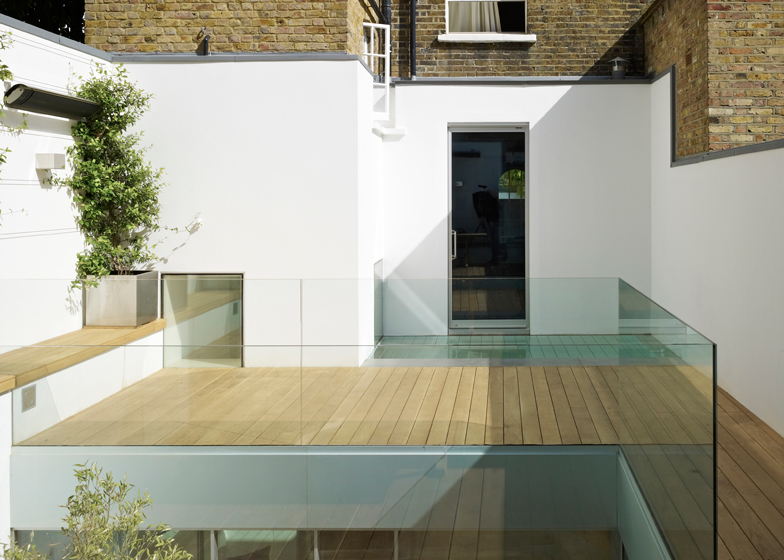A sunken courtyard brings daylight down into the new living room and study of this north London home, added by Coffey Architects in place of an old garage.
Located in a conservation area in Islington, the three-storey Georgian house previously had no garden, only a narrow courtyard that was permanently in shadow because of the garage at the rear of the property.
London-based Coffey Architects was tasked with re-planning the area, creating new indoor and outdoor spaces for the clients – a newly married couple with a baby on the way.
The team felt the best way to do this was to demolish the garage and excavate part of the ground. This allowed them to create two new basement rooms with a garden terrace on the roof.
"The house suffered from a lack of light into the lower ground floor, and also that it did not have a garden," studio founder Phil Coffey told Dezeen.
"We did a number of options, finally deciding on knocking down the garage, digging a basement and adding a light courtyard and glass floor to the newly formed garden area."
A living room was created nearest the house as a continuation of the existing dining room, and a small study was added at the back, which can also function as a guest bedroom when the couple have visitors.
To allow plenty of daylight to reach these two windowless rooms, a sunken courtyard framed by three glass walls was slotted in between them. Skylights were also added above the living room, which allows more light to reach the dining area.
A concrete floor runs through the entire space. It steps down for the living room, which is set slightly slower than the rest of the floor, then steps back up for the courtyard and study. It also forms a staircase leading up to the roof garden and frames a raised fireplace in the living room.
"A fireplace is 'stretched' from the existing lower ground floor to connect the new underground room with the kitchen in the house, and strengthens the cohesion between old and new," said Coffey.
Glazing is kept as simple as possible with slender steel frames. Frameless glass was also used to create balustrades around the edges of the roof deck. According to Coffey, the aim was to create a "delicate modernity".
"There are two types of material – those that get better with age and those that don't," he told Dezeen. "Self-finish materials get better with use, have no need for decoration, reduce maintenance, and are also often recyclable."
"Stainless steel, glass, concrete and white walls are ubiquitous, but when controlled to offer tight complex enclosure they show the simplicity and confidence of the architecture," he added.
Planters containing both plants and trees were added in the courtyard. They were also dotted around the roof terrace, along with built-in seating covered in the same wood as the decked flooring.
Court House was shortlisted in the extensions category of Don't Move Improve 2014, which awards the best of London's house extensions and renovations. Winners included a new end to a 1960s housing block and a home with a combined bookshelf-staircase.
Photography is by Timothy Soar.

